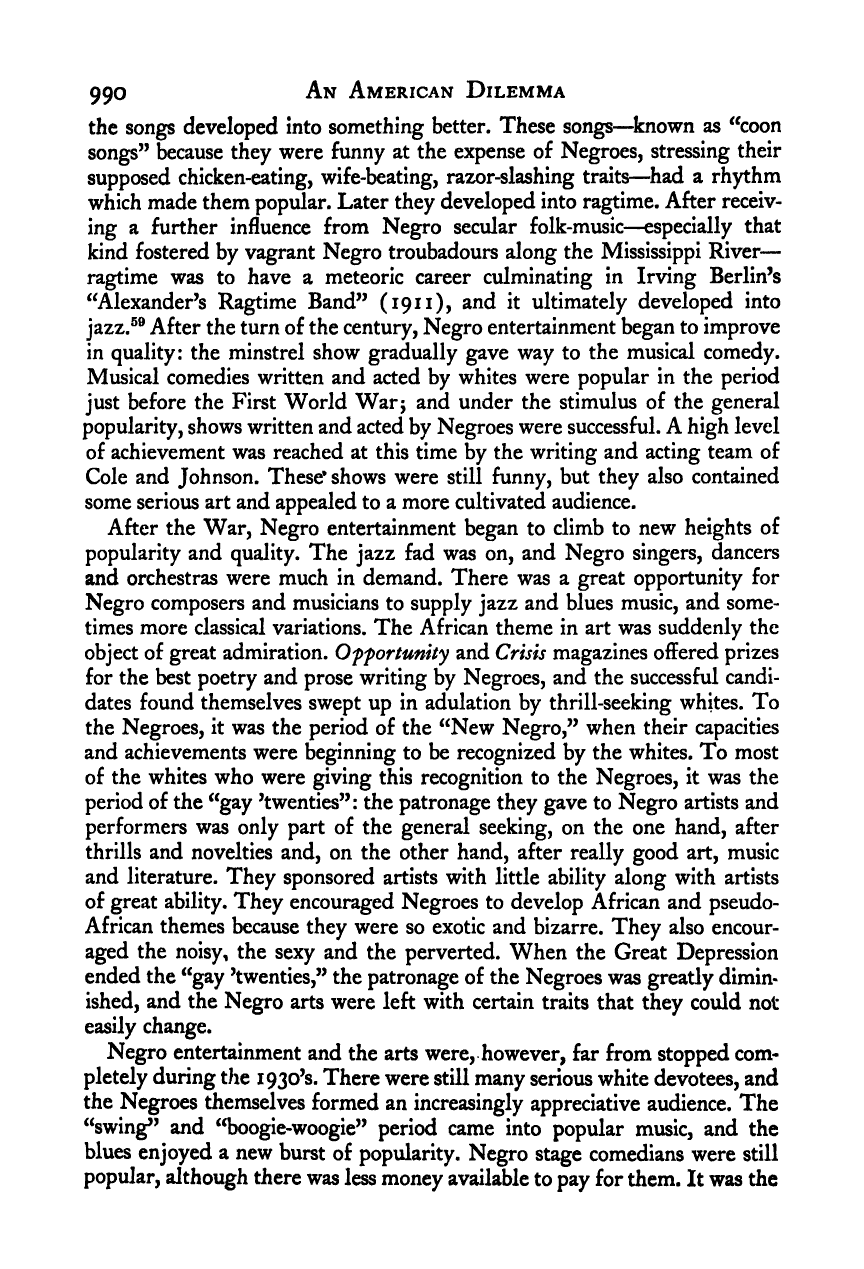Note: Gunnar Myrdal died in 1987, less than 70 years ago. Therefore, this work is protected by copyright, restricting your legal rights to reproduce it. However, you are welcome to view it on screen, as you do now. Read more about copyright.
Full resolution (TIFF) - On this page / på denna sida - X. The Negro Community - 44. Non-Institutional Aspects of the Negro Community - 5. Negro Achievements

<< prev. page << föreg. sida << >> nästa sida >> next page >>
Below is the raw OCR text
from the above scanned image.
Do you see an error? Proofread the page now!
Här nedan syns maskintolkade texten från faksimilbilden ovan.
Ser du något fel? Korrekturläs sidan nu!
This page has never been proofread. / Denna sida har aldrig korrekturlästs.
990 An American Dilemma
the songs developed into something better. These songs—^known as ^^coon
songs” because they were funny at the expense of Negroes, stressing their
supposed chicken-eating, wife-beating, razor-slashing traits—had a rhythm
which made them popular. Later they developed into ragtime. After receiv-
ing a further influence from Negro secular folk-music—especially that
kind fostered by vagrant Negro troubadours along the Mississippi River
—
ragtime was to have a meteoric career culminating in Irving Berlin’s
“Alexander’s Ragtime Band” (1911), and it ultimately developed into
jazz.®® After the turn of the century, Negro entertainment began to improve
in quality: the minstrel show gradually gave way to the musical comedy.
Musical comedies written and acted by whites were popular in the period
just before the First World Warj and under the stimulus of the general
popularity, shows written and acted by Negroes were successful. A high level
of achievement was reached at this time by the writing and acting team of
Cole and Johnson. These* shows were still funny, but they also contained
some serious art and appealed to a more cultivated audience.
After the War, Negro entertainment began to climb to new heights of
popularity and quality. The jazz fad was on, and Negro singers, dancers
and orchestras were much in demand. There was a great opportunity for
Negro composers and musicians to supply jazz and blues music, and some-
times more classical variations. The African theme in art was suddenly the
object of great admiration. Offortunity and Crisis magazines offered prizes
for the best poetry and prose writing by Negroes, and the successful candi-
dates found themselves swept up in adulation by thrill-seeking whites. To
the Negroes, it was the period of the “New Negro,” when their capacities
and achievements were beginning to be recognized by the whites. To most
of the whites who were giving this recognition to the Negroes, it was the
period of the “gay ’twenties”: the patronage they gave to Negro artists and
performers was only part of the general seeking, on the one hand, after
thrills and novelties and, on the other hand, after really good art, music
and literature. They sponsored artists with little ability along with artists
of great ability. They encouraged Negroes to develop African and pseudo-
African themes because they were so exotic and bizarre. They also encour-
aged the noisy, the sexy and the perverted. When the Great Depression
ended the “gay ’twenties,” the patronage of the Negroes was greatly dimin-
ished, and the Negro arts were left with certain traits that they could not
easily change.
Negro entertainment and the arts were, however, far from stopped com-
pletely during the 1930’s. There were still many serious white devotees, and
the Negroes themselves formed an increasingly appreciative audience. The
“swing” and “boogie-woogie” period came into popular music, and the
blues enjoyed a new burst of popularity. Negro stage comedians were still
popular, although there was less money available to pay for them. It was the
<< prev. page << föreg. sida << >> nästa sida >> next page >>